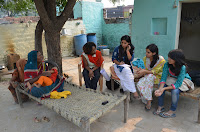Mallampet village in Qutubhullapur Block in Hyderabad is one of the most rapidly urbanizing villages in the city. A number of high-rise residential colonies have sprung up in the vicinity along with many industrial units around this village. As a result of widespread land development and commercial activities, the farmers and land owners of this village have particularly suffered as many culverts that supplied water are now broken and there is inadequate water supply for their fields. Also, a number of tanker operators are abstracting ground water from this village to sell it to the surrounding areas. This has made farming a less viable occupation, and farmers prefer selling off their lands or installing bore-wells in their fields for selling water as a more lucrative option. Another major setback has been the construction of the Outer Ring Road (ORR) through the outer boundary of the village. This road is actually cutting across a major water body called the ‘Khatwa tank’ which has been the source of livelihood for a number of fishers and source of water to the farms of many. A large part of the water body has been encroached upon for this construction.
We met another senior official of the Buddha Purnima Project Authority (BPPA) next. This authority is responsible for the protection and development of Husain Sagar Lake and its environs in 902 ha. He started explaining how the encroachment process by the land mafia works – the recharge points of the lake are blocked first. When the water channels are blocked, the lake automatically dries up and gradually becomes a dumping ground. It is encroached upon later by informal settlements and ultimately the land is sold off to a private developer.
Hyderabad Metropolitan Development Authority or HMDA is the urban planning agency, and is responsible for the construction of the ORR. Formed in 2008 after merging erstwhile entities of Hyderabad Urban Development Authority (HUDA), Hyderabad Airport Development Authority (HADA), Cyberabad Development Authority (CDA) and Buddha Poornima Project Authority (BPPA), it covers the entire area of Greater Hyderabad Municipal Corporation and its suburbs. It coordinates the development activities of the municipal corporations, municipalities and other local authorities, the Hyderabad Metropolitan Water Supply & Sewerage Board, the Andhra Pradesh Transmission Corporation, the Andhra Pradesh Industrial Infrastructure Corporation, the Andhra Pradesh State Road Transport Corporation, and other such bodies.
According to the map of the master plan 2021 (http://www.hmda.gov.in/ViewMap.html), the road is not supposed to cut across the tank but on ground, the situation is far from the proposed version. Enquiring more on this dichotomy and finding out the department responsible for the situation is what brought us to the HMDA office.
After moving from one table to another and unable to locate even one contact person to be able to speak to, finally we were directed towards the Planning Office. Moving through labyrinthine corridors and passing one department after the other, we reached the concerned office. A senior official heard our case patiently, and then explained how the HMDA is responsible for executing the master plan and building the physical infrastructure. “We are not looking at the protection of lakes or providing water to the communities, that is looked after by the lakes department”, he said. The construction of the ORR is as per the master plan and our job is to stick to it. The HMDA has no role with any village development activity”, he added. We also got to know that a minimum buffer zone of 10m is supposed to be kept around the lake, which has been clearly violated in Mallampet’s case.
Our next meeting was at the Lakes Division where we spoke to an Executive Engineer. An enthusiastic official – he narrated how the department was involved in lake protection and development projects. Hyderabad is a city with currently about 400 small and large lakes or tanks and managing each and every water body is not an easy task for the authorities. The HMDA is increasingly encouraging the corporate sector to adopt and take responsibility of a lake and help them in their endeavour. Waterfronts of a few lakes in Hyderabad have been developed with walkways and landscaping. There is also a Lake Development Authority (LDA) which is an autonomous and regulatory body formed to take remedial measures and to restore and revitalize the dying lakes. Regarding, the ORR, the official only had one question to ask, “How can the ORR pass through the lake?”
We met another senior official of the Buddha Purnima Project Authority (BPPA) next. This authority is responsible for the protection and development of Husain Sagar Lake and its environs in 902 ha. He started explaining how the encroachment process by the land mafia works – the recharge points of the lake are blocked first. When the water channels are blocked, the lake automatically dries up and gradually becomes a dumping ground. It is encroached upon later by informal settlements and ultimately the land is sold off to a private developer.
But the case of the government being involved in encroaching upon a lake came as a big surprise and he out-rightly denied any information on the situation in Mallampet. However, he also asked us to give evidence on this situation based on which they can take the issue forward. “We need the wisdom of NGOs to work accordingly”, he remarked.
There are various wings and departments under the urban authority in charge of the ‘planned development’ of the Hyderabad metropolitan region. But one can easily gauge the exclusivity in the functioning of these departments where information with one department is limited within its own making the authorities unaware of the ground situation as well as of the overlapping issues and facts. As much as the NGOs have to work closely with the governments on cross-cutting issues, the government departments must also make efforts to be in sync with one another especially those dealing with the same issue.










